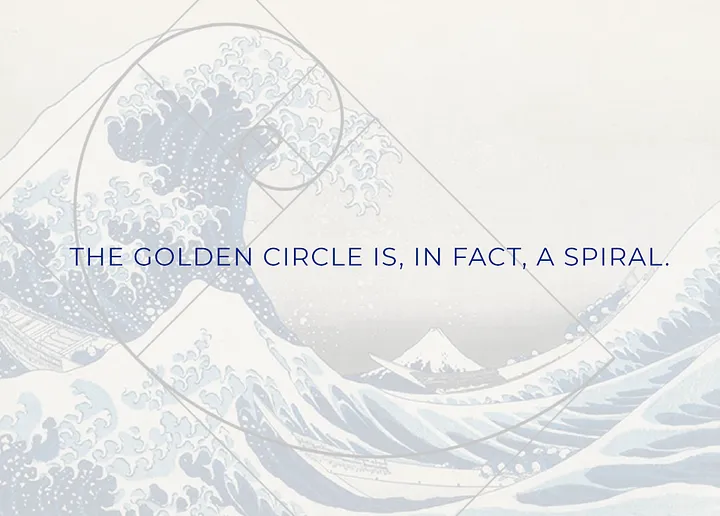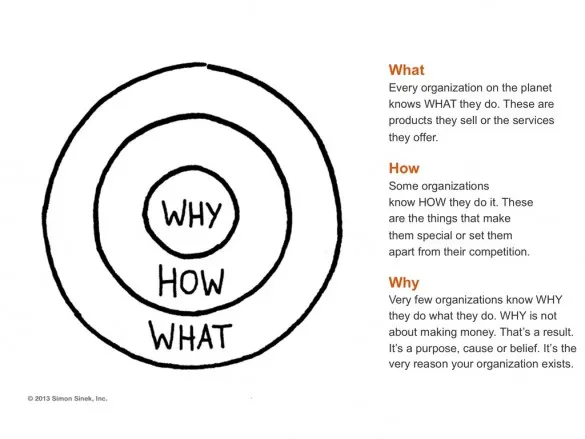The Golden Circle is, in fact, a spiral

So everyone knows the Golden Circle by Simon Sinek, right? What if I told you that it isn’t a circle but a spiral. Yes, you’re looking at it from above.
Let’s recap. Here is what the Golden Circle is all about:

Since I first watched his Ted Talk a few years ago, this had become one of my mantras. As a creative in advertising, you need to understand the brand you’re communicating and the business behind it. And, for me, in order to understand a company, you needed to understand their why, their purpose. As a strategist, for me, finding the why of my clients help me to find their uniqueness. Once we find it, this will be the factor that will make us stand out from the competition. Because, as
dave trott says in his latest Campaign article, ‘If we fit in and no-one notices us, we’ve wasted our money. If no-one notices us, we may as well not be running any advertising at all.’
But over the years, I began feeling that this formula was missing something — I spent a lot of time wrapping my head around what defines your purpose. Why is that your why? (Not confusing at all, right?). When you’re starting a business, creating a product, running a non-profit, your purpose is based on someone. Understanding people, their feelings, their thinking, and their stories are what’s going to make it relevant for them. Empathy is a powerful tool when you’re doing something for others. In business, you’re always doing something for someone: clients, audience, users, the general public, stakeholders, etc.
The why of your business is entirely emotional, but when doing business, your products, project, or service needs to make sense and fit into your competitive analysis. Your marketing plan, based on the what and how of a company, is — and has to be — completely rational. And there is no way that when you start a business you looking for the why before the how and what. The why, is part of your communication plan which comes after you have a product, a defined audience, and a UVP — or how.
But what’s at the center, in reality, it doesn’t matter. Simon Sinek gives examples of successful companies such as Apple, Tesla, or even his example of Martin Luther King or the Wright Brothers. None of them started with a why, they started with a solution to a real problem, a real problem that was discovered by the observation of their surroundings. The why came after, as well as the what and how. But the who was the spark that ignited the cycle.
Even though it’s not explicit, at the core of the circle is why, but at the core of why, is who. Because if you don’t think of your audience, their interests, and likes, your purpose won’t have the right focus, but more importantly, your product won’t be based on a person’s problem, which leads to an unguaranteed demand or audience.
But as I said before, the Golden Circle, is, in reality, a spiral, and it’s not an image, but a movie. That’s why it doesn’t really matter what’s at the center, because it’s always moving, always improving. And you don’t need to start with why, you can start with what or how, as long as you are solving a problem for a who. Successful products or services serve a simpler solution to an already existing problem. Wherever you start, you move along and define the other part of the equation: if you have the what — your product or service — work on your how — your internal processes, your UVP, or whatever it is that sets your product apart from the competition. Your why aims to connect with your audience in an emotional way. The why is your purpose, your branding, the perception that you build around the intrinsics of your product to add value. When you have everything figured it out it’s over…but is it, really? On the contrary, it’s just the beginning.
Branding is not a one-and-done deal but a launch-analyze-iterate type of work. Yes, branding is an everyday task and it’s always evolving. You work on your why based on the who, then on your how and finally your what but, once you have this, the whole context has changed. Now the world knows about your brand, your clients are expecting something else from you, the competition had caught up, and now is time for you to start again. Based on the who: have your audience changed? What about your purpose? Did you change processes or the way of doing things? Have all these have affected your final product? Once you’re done, you’re starting all over, again. In Japanese culture, they call it Kaizen. With every turn around the circle, your knowledge about these fundamental pillars of your business get more specific and the value of your brand grows higher.

So it doesn’t really matter if you start with why, how, or what as long as your start. But before you do, ask yourself, am I solving a real problem? Are we doing someone’s life easier? That’s how you’ll know if you’re ready to start.
Thank you for coming to my TedTalk (?)

